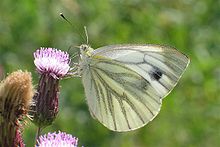Butterfly
The classification of living organisms into systematics is a continuous subject of research. Thus, various systematic classifications exist side by side and one after the other. The taxon discussed here has become obsolete due to new research or is not part of the systematics presented in the German Wikipedia for other reasons.
Butterflies from various families that fly mainly during the day are grouped together under the name butterflies. The butterflies in the narrower sense, however, forms only one group of families, which are actually all closely related to each other.
Most butterflies have button-shaped, thickened feeler ends in common, which is why they used to be grouped together in science as Rhopalocera ("true butterflies", literally "button horns"). Some of this group includes very large and colourful species. Butterflies usually fly in a typical tumbling flight, so their flight path is relatively difficult for birds to predict, which makes them unattractive as prey.
The group of butterflies in the narrower sense includes the following families:
- Bluebottles (Lycaenidae)
- Cube butterfly (Riodinidae)
- Bullhead butterfly (Hesperiidae)
- Knight butterfly (Papilionidae)
- Noble butterfly (Nymphalidae)
- White butterflies (Pieridae)
Besides morphological work, the analysis of relationships in biology is increasingly based on the comparison of homologous DNA sequences. As a result of these studies, the "classical" butterflies can be considered as a monophyletic group, if the small family of Hedylidae is added from the "moths". The following cladogram illustrates the possible relationships:
However, some positions in it are not yet completely certain. This concerns the Hedylidae, which alternatively could also be sister group of the Hesperiidae, and the position of the Pieridae. All modern studies, however, agree on the position of the Papilionidae as sister group of the other Papilionoidea, not, as previously assumed, of the Hesperiidae. Thus, neither a superfamily Hesperioidea nor a separate taxon Rhopalocera exists.
There are also some "moth" families and species that specialize in daytime activity. Some of these also have brightly coloured, conspicuous wings, such as the damselflies. Some butterflies (of the superfamily Papilionoidea) have inconspicuous "moth"-like wing colors and markings. Thus, diurnal activity and coloration alone are not useful as systematic characters.

The rape white butterfly, a day butterfly
Questions and Answers
Q: What is a butterfly?
A: A butterfly is an insect of the order Lepidoptera that usually flies during the day. They are grouped together in the suborder Rhopalocera and are closely related to moths.
Q: How long have butterflies been around?
A: The earliest discovered fossil moth dates back to 200 million years ago, while the earliest known butterfly fossils date to 40-50 million years ago.
Q: What do butterflies look like?
A: Butterflies have four wings covered with tiny scales and they often have brightly colored patterns on their wings. Males and females of each kind may be slightly different from each other in appearance.
Q: What is butterfly watching?
A: Butterfly watching is a popular hobby where people observe live butterflies in their natural environment or keep collections of dead butterflies that they have caught.
Q: What stages does a butterfly's life cycle go through?
A: A butterfly's life cycle goes through four distinct stages - egg, larva (caterpillar), chrysalis, and adult butterfly. After mating, females lay eggs which then hatch into larvae which turn into chrysalis before emerging as adult butterflies.
Q: What order do butterflies belong to?
A: Butterflies belong to the insect order Lepidoptera along with moths and skippers.
Q: Where can you find butterflies?
A: Butterflies can be found nearly worldwide due to their wide distribution range.
Search within the encyclopedia